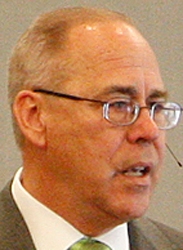Keep it simple, UNLV chief says of higher ed funding formula
The biggest topic in the state's higher education circles right now is the pending rewrite of the funding formula.
This is no small matter. This year, state support to higher education will be nearly half a billion dollars.
The formula, its current form so complicated few people understand it, is what the state's lawmakers use to figure out how much money to allocate to each of the state's colleges and universities.
It is being studied by a committee right now. Proposals are being floated. A consulting group may be brought in.
Which means it is time for the interested parties to pitch their cases.
That's what UNLV President Neal Smatresk did Tuesday before a friendly crowd.
"We need to keep it fairly simple, and we need to do it now," he told the university's faculty senate.
The current formula, which has been in place for decades, essentially assigns dollars to a college or university based on how many students are enrolled.
That's a problem, many in higher ed say, for a couple of reasons. First, it costs more to educate some students than it does others. An engineering degree, for example, is lots more expensive to produce than a history degree is.
Second, simply "rewarding" enrollment encourages growth for its own sake, rather than encouraging the colleges and universities to make sure those who enroll eventually graduate.
The state's higher education graduation rates are universally poor.
Third -- and Smatresk said this one is critical -- the funding model now used essentially punishes institutions such as UNLV that enroll large numbers of out-of-state students.
Out-of-state students pay much more in tuition than in-state students do, and UNLV by far has the most out-of-state students in the state, largely because of its highly regarded hotel college.
But the university does not get to keep the tuition those students pay. The way it works now is student tuition and fees raised at an institution are essentially subtracted from the state support that institution gets.
Smatresk said the university "loses" about $14 million a year under this policy. Even if the formula were not going to be rewritten, he said, changing this one piece of the puzzle would benefit UNLV greatly.
"If just that happens," he said, "we will be in much stronger shape than we are now."
Publicly, nearly everyone has expressed at least timid support for a proposal floated by the state's higher education chancellor, Dan Klaich. The proposal, still in its infant form, would reward high graduation rates rather than enrollment, allow the institutions to keep the tuition and fees they raise, and allocate more money for more expensive courses.
Faculty senate President Greg Brown said there were at least two areas of concern. First, whatever form the new formula takes, it must accurately measure the cost of programs. Second, faculty should be mindful of "grade inflation," that phenomenon whereby there is pressure on the faculty to make sure students graduate, regardless of learning.
Privately, nearly everyone is worried that these or other problems with the formula rewrite will crop up.
The people at the universities worry that their higher costs won't be taken into account; people at the College of Southern Nevada worry that its sheer size will hurt it; people at Nevada State College worry that its largely nontraditional student population -- large numbers of poor, minorities and first-generation students -- won't graduate quickly enough or in large enough numbers.
Students worry that a formula rewrite will mean higher tuition and fees, and all three southern institutions worry that nothing will change when it comes to what they see as funding inequities, namely that the majority of state tax dollars are raised in Southern Nevada, but only half the higher ed dollars are spent here.
All of which is why Smatresk encouraged the faculty to get involved.
Contact reporter Richard Lake at rlake@reviewjournal.com or 702-383-0307.




























